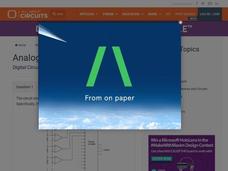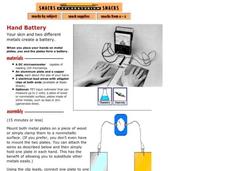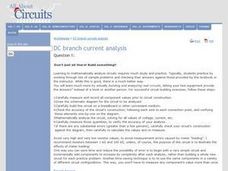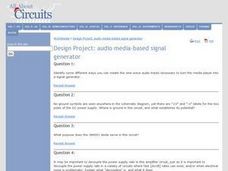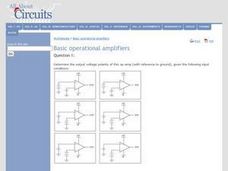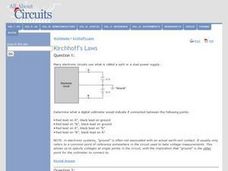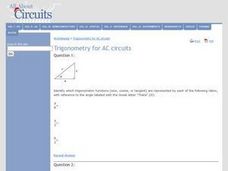Curated OER
Digital-to Analog Conversion
In this electrical circuit worksheet, students answer a series of 13 open-ended questions about digital-to-analog converter circuits. They analyze schematics in order to answer the questions. This worksheet is printable and the answers...
Curated OER
Analog to Digital Conversion
In this electrical circuit worksheet, students answer a series of 18 open-ended questions about analog to digital converter circuits. They analyze schematics in order to answer the questions. Students design and build an analog to...
Curated OER
Connecting the Dots
Learners consider familiar audio and imaging devices, researching and analyzing the differences between analog and digital versions. They then reflect on which versions of the technology provide a truer record over time.
Curated OER
To The Clock of Eras
Third graders investigate the events of geological time using a chart called a "Clock of Eras". In this geological events lesson plan, 3rd graders compare a standard clock to a geological clock. In addition, students consider periods...
Curated OER
High-Definition Digital Television: Why Make the Switch?
In this digital television worksheet, students read about the advantages of using digital television. They answer three critical thinking questions about the advantages and disadvantage of digital television.
Curated OER
Digital Logic Signals
In this electronics activity, students interpret schematic diagrams and analyze circuit components to answer 9 short answer and problem solving questions.
Utah Education Network (UEN)
Utah Open Textbook: 8th Grade Science
The cycle of energy is important to many different systems on Earth. Scholars use questioning and observation to investigate the differences between renewable and non-renewable resources and how they relate to global changes. They...
International Technology Education Association
Reinventing Time
Take a trip through time. A lesson resource provides instruction on the origin of current measurements for time. The text explains the different tools humans used throughout history to measure time as well as provides examples such as...
Curated OER
Building a Computer
In this computer worksheet, students read about computers and the definition of a computer. They build a simple computer using two rulers and learn to add numbers using the computer they build. They answer three critical thinking...
Exploratorium
Hand Battery
Get hands-on in your physical science class by having learners conduct electricity with their own hands! By placing one hand on each of two different metals, a current can be generated and measured on a microammeter. Make an experiement...
Curated OER
DC Branch Current Analysis
Engage your class in physics with this series of questions. The first question is the most hands-on and asks learners to build their own circuit. The rest of the questions are related to current analysis. Class members solve 7 problems...
Curated OER
Calendar Time
Use circle time to work on counting. Kindergarteners practice the months of the year, say the full date, chart the day's temperature, count to 100, and sing the alphabet song. This kind of daily routine cultivates deep roots for...
Curated OER
Design Project: Audio Media-based Signal Generator
For this physics worksheet, students are given a schematic diagram to construct an amplifier circuit. They complete 4 short answer questions about the circuit they made.
Curated OER
Binary and Communication Systems
Students participate in an activity that introduces them to the concept of binary coding as a language. They decode messages using special boards that has its own code for different letters. They create new codes by rearranging wires...
Curated OER
Basic Voltmeter Use
In this voltmeter worksheet, learners answer 12 questions about voltmeters connected to batteries, ohmmeters and circuits. They determine how much voltage would register on a voltmeter given diagrams of circuits.
Curated OER
Basic Operational Amplifiers
In this electronics worksheet, students analyze different amplifier circuits and answer 18 short answer and problem solving questions about them.
Curated OER
Kirchhoff's Laws
In this circuit worksheet students study electronic circuits and how they get power. Students determine polarity and magnitude and work with Kirchoffs laws to answer 48 questions regarding circuits. Answers are revealed when selected.
Curated OER
Basic Logic Gates
In this physics worksheet, students identify the different types of logic gates shown by the schematic diagram. They write short answers to 12 questions on logic gates.
Curated OER
Design Project: Arbitrary Waveform Generator
In this electronics worksheet, students build a circuit that can produce desired waveforms. They answer 1 short answer question that follows.
Curated OER
High Reliability Circuits
In this physics circuits worksheet, students calculate and write short answers to 9 questions about high reliability circuits. They solve and draw schematic diagrams.
Curated OER
The Physics of Cell Phones
Students explain how cell phones work. In this physics lesson, students describe the advantages and advantages of having one. They identify the different parts of a cell phone.
Curated OER
Switches
In this switches worksheet, students solve 18 problems about types of switches, circuits, the voltage of the switches, the contact status and the number of poles and throws in switches.
Curated OER
Capacitors
In this physics worksheet, students identify the parts and function of different types of capacitors. They solve and write short answers to 15 questions.
Curated OER
Trigonometry for AC Circuits
For this physics worksheet, students solve 23 trigonometry based problems. Students apply the Pythagorean Theorem in electricity calculations.

